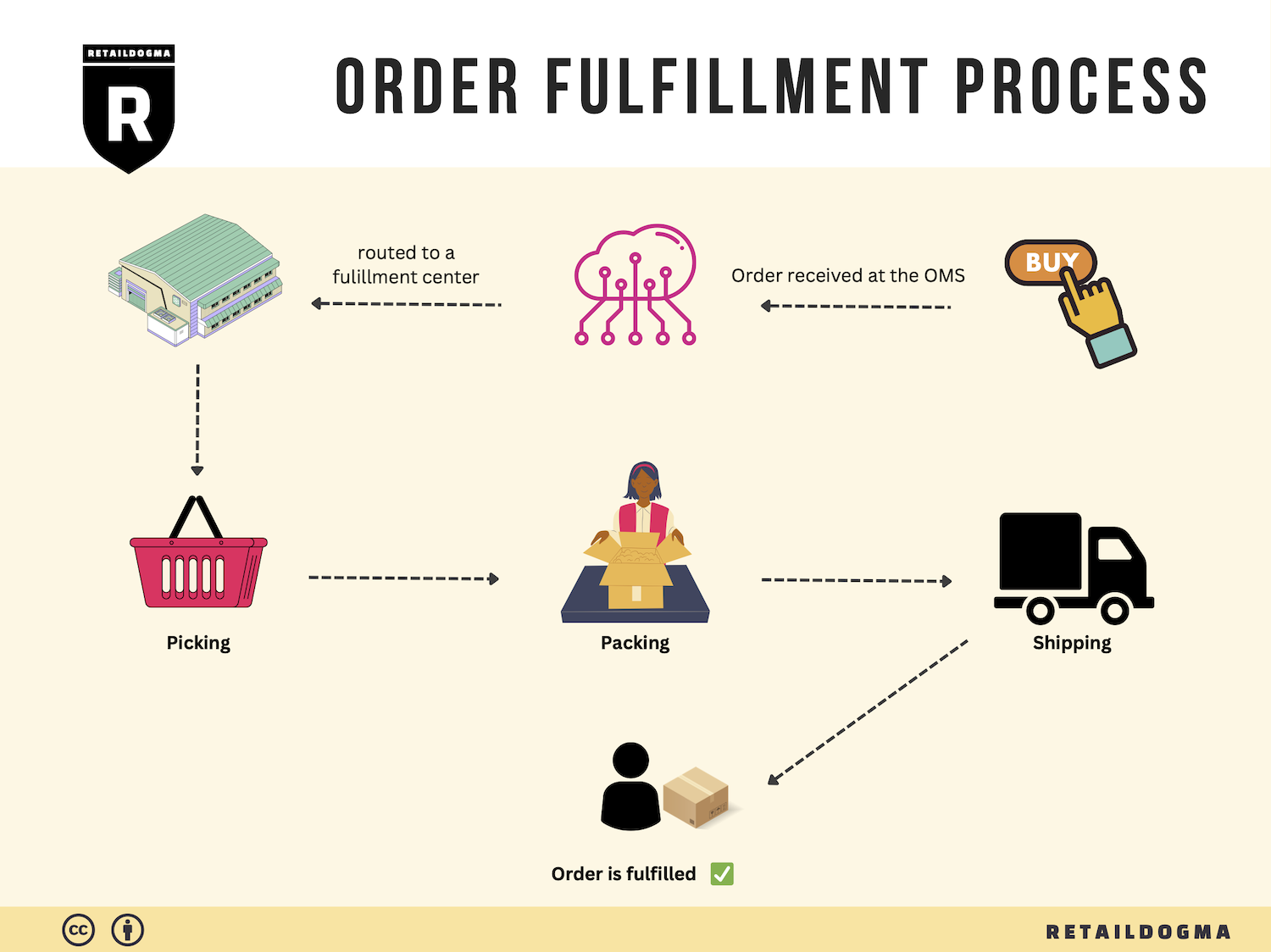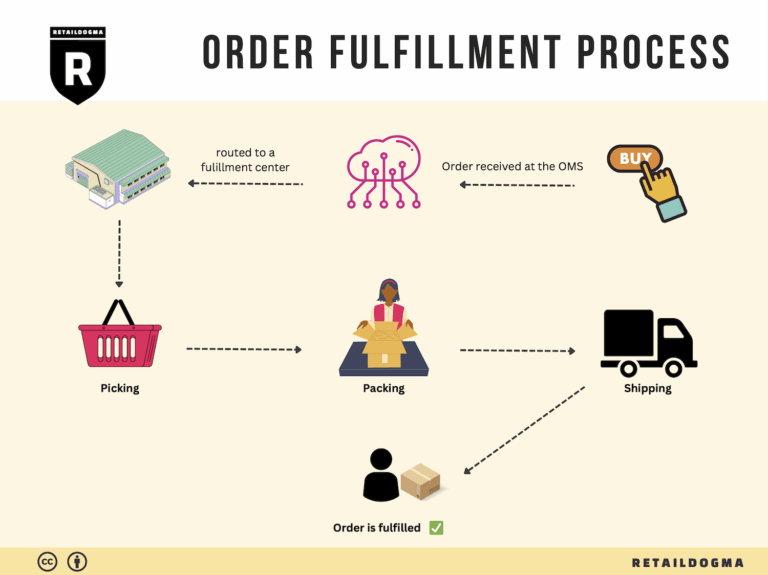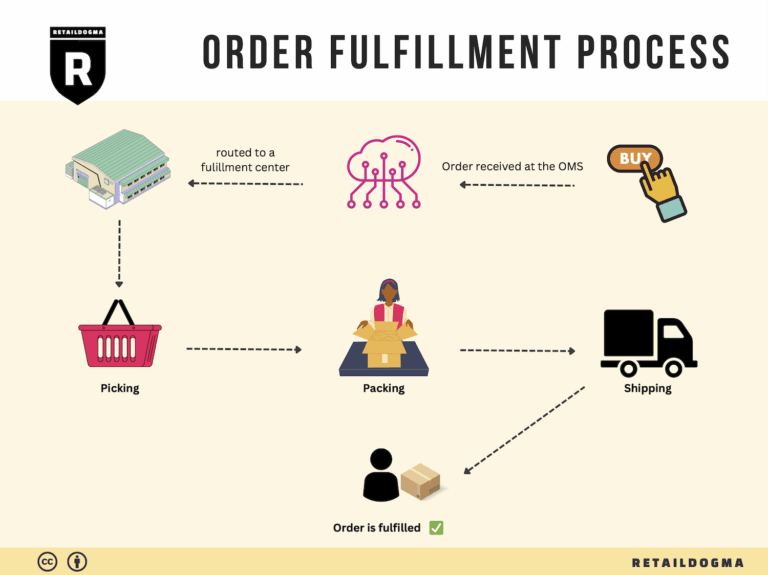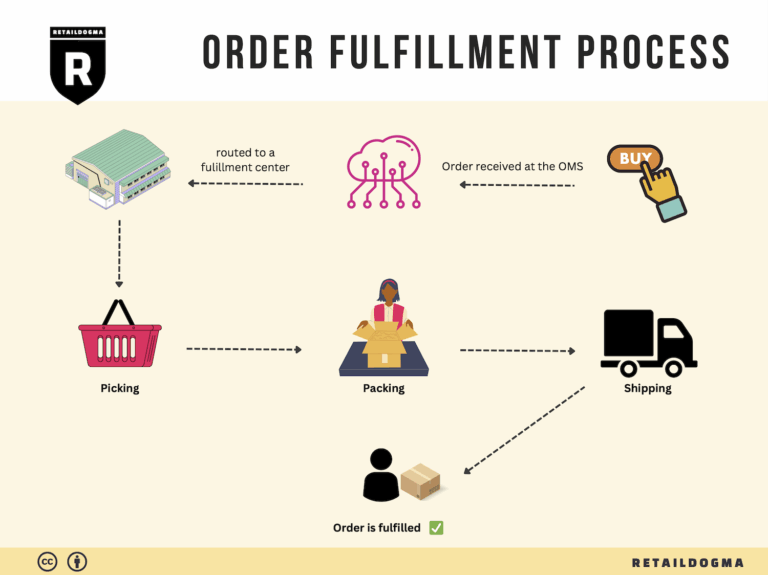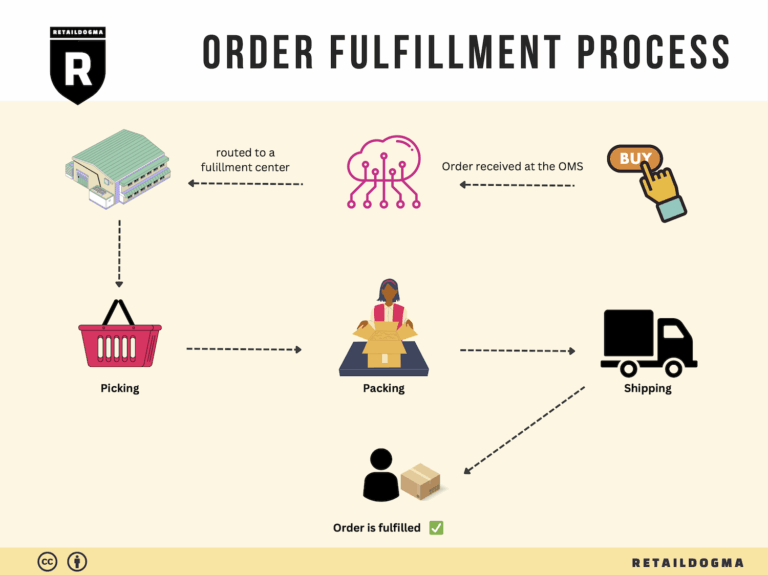Ecommerce Fulfillment Services: The Ultimate Guide (2025)
What is E-commerce Fulfillment? An Introduction for Growing Businesses
As your e-commerce business grows, one of the most common challenges you may face is managing the increasing volume of orders. The excitement of acquiring new customers can quickly turn into stress when you’re overwhelmed with packing and shipping each order. This critical aspect of your operation—getting products to your customers efficiently and accurately—is known as fulfillment. In simple terms, fulfillment is the process of receiving, processing, and delivering orders to customers.
For many growing businesses, handling fulfillment in-house can become a logistical nightmare, diverting your focus from core business activities such as marketing and product development. That’s where understanding various fulfillment models becomes essential. This guide will explore different fulfillment options, including Third-Party Logistics (3PL) and Fulfillment by Amazon (FBA), helping you understand the pros and cons of each.
Understanding Fulfillment Models
In this guide, we will delve into various fulfillment models. 3PL providers, like DCG Fulfillment, offer comprehensive services that can scale with your business needs, from warehousing to shipping. On the other hand, FBA allows you to leverage Amazon’s massive distribution network but may come with higher fees and less control over your inventory.
Core Fulfillment Services
We will outline core fulfillment services, including order pick-and-pack, inventory management, and shipping solutions. Understanding these services will help you identify what you need based on your business size and customer expectations.
Choosing the Right Fulfillment Partner
Selecting the right fulfillment partner is crucial for your business’s success. We will discuss key factors to consider, such as service reliability, technology capabilities, and customer support, to ensure you make an informed choice.
Pricing Considerations
Finally, we will provide insights into pricing models and what to expect in terms of costs. Knowing how fulfillment pricing works will allow you to budget effectively and identify areas where you can optimize expenses.
The ultimate goal of this guide is to empower you to make informed decisions about your logistics strategy. By understanding the ins and outs of e-commerce fulfillment, you can streamline your operations, enhance customer satisfaction, and focus on scaling your business without getting bogged down in logistics. With the right knowledge and tools, fulfillment can transform from a daunting challenge into a seamless component of your e-commerce success.
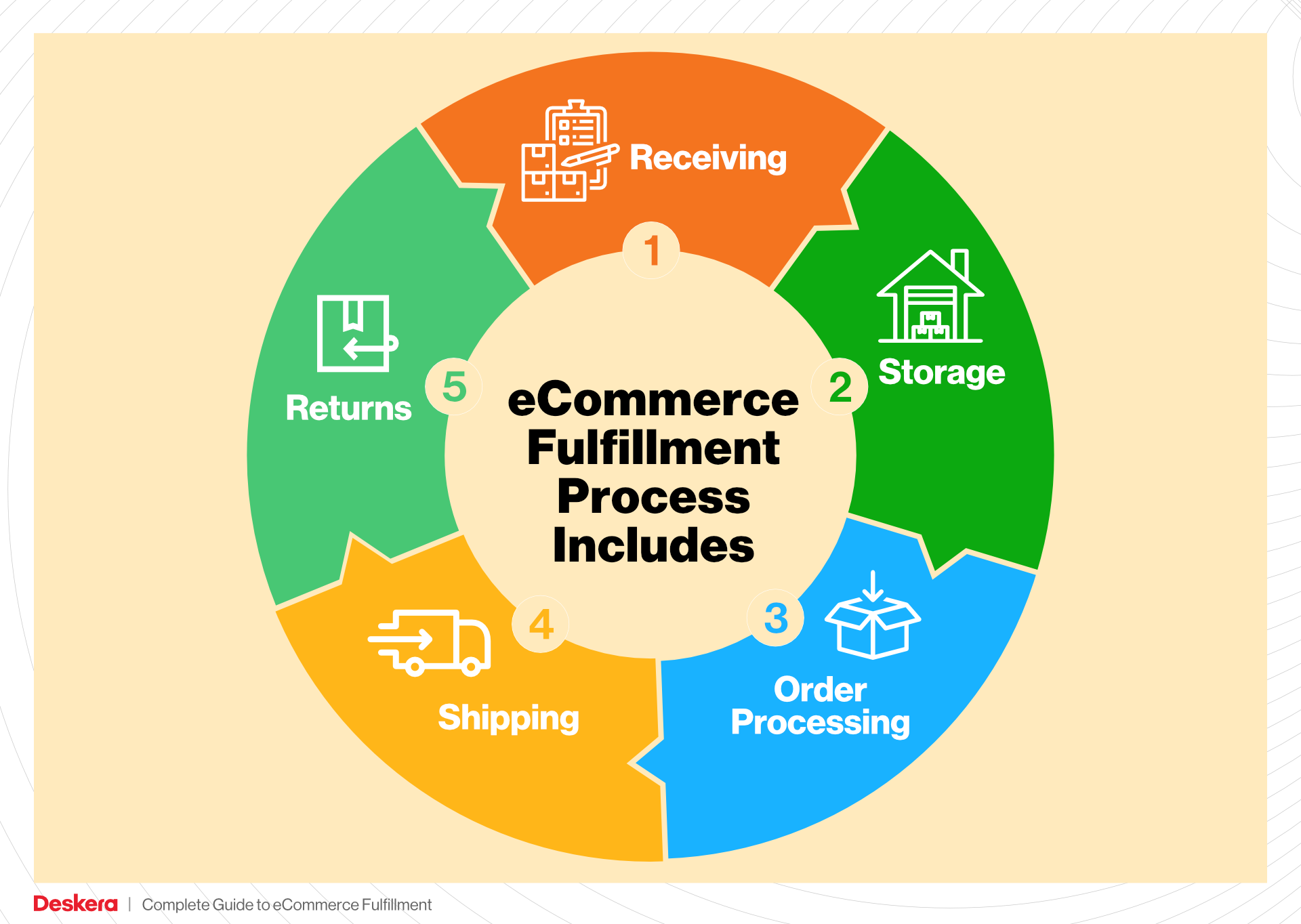
What You’ll Learn In This Guide
- What is E-commerce Fulfillment? An Introduction for Growing Businesses
- The Order Fulfillment Process: From ‘Buy’ Button to Customer’s Door
- Comparing Fulfillment Models: In-House vs. 3PL vs. Dropshipping
- A Deep Dive into Amazon FBA: Pros, Cons, and Who It’s For
- Core Services Offered by Fulfillment Centers
- How to Choose a Fulfillment Partner: A 6-Point Checklist
- Understanding Fulfillment Pricing: A Breakdown of Common Fees
- Frequently Asked Questions (FAQs) about Fulfillment
- Conclusion: Is Outsourcing Fulfillment the Right Move for Your Business?
- Important Disclaimer
The Order Fulfillment Process: From ‘Buy’ Button to Customer’s Door
1. Receiving Inventory
The order fulfillment process begins with receiving inventory, a critical step that ensures that your warehouse is stocked with the products customers want. Upon delivery, inventory is checked against purchase orders to confirm that the correct quantities and items have arrived. This process typically involves labeling items with Stock Keeping Units (SKUs), which are unique identifiers that help track products throughout the supply chain.
Importance: Accurate receiving is vital to maintaining inventory integrity. Errors in this step can lead to stock discrepancies, which may result in stockouts or overstock situations, ultimately affecting customer satisfaction and your bottom line.
Key Term: SKU (Stock Keeping Unit) – A unique identifier for each distinct product and service that can be purchased, essential for tracking and managing inventory.
2. Warehouse Storage
Once inventory is received, it is stored efficiently within the warehouse. This step involves organizing products in a manner that maximizes space while ensuring easy access for order fulfillment. Warehouses often utilize various storage solutions, such as pallet racks, shelving, and bins, depending on the nature and size of the products.
Importance: Proper warehouse storage is crucial for optimizing picking efficiency and minimizing retrieval times. An organized warehouse reduces the likelihood of errors and accelerates the overall fulfillment process, ensuring that products are readily available for order picking.
Key Term: FIFO (First In, First Out) – An inventory management method where the oldest stock is sold first, which is especially important for perishable goods to minimize waste.
3. Order Picking
The next step in the fulfillment process is order picking, where items are retrieved from storage based on customer orders. This process can vary in complexity, from single-order picking, where one order is filled at a time, to batch picking, where multiple orders are picked simultaneously. Pick lists, which outline the specific items and quantities needed for each order, guide this process.
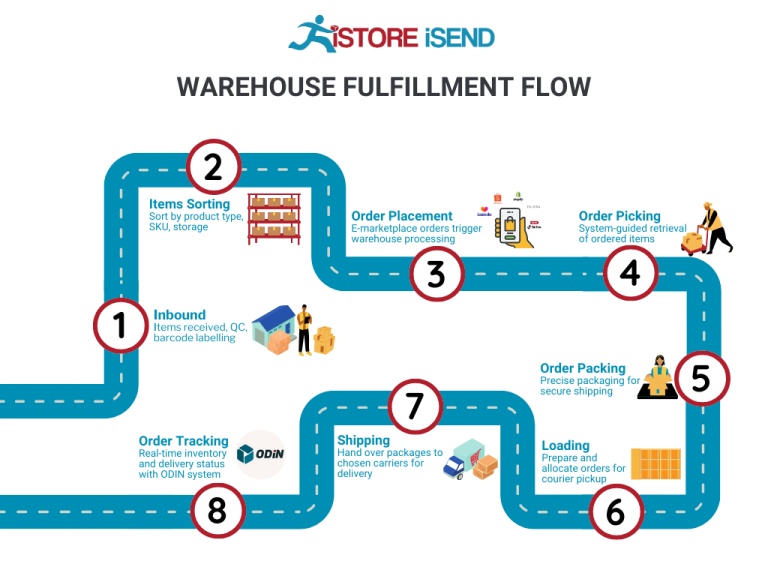
Importance: Efficient order picking directly impacts delivery speed and accuracy. The faster and more accurately items are picked, the more satisfied customers will be with their orders. Moreover, optimizing the picking process can significantly reduce labor costs.
Key Term: Pick List – A document or digital list that details the items to be collected for an order, serving as a guide for pickers to ensure accuracy and efficiency.
4. Order Packing
After items have been picked, the next step is order packing. This involves carefully packing the items to ensure they are protected during transit. During this stage, packing materials are selected based on the nature of the products, and packing slips are generated to accompany the order. Scan verification processes can also be employed to double-check that the correct items are packed.
Importance: Proper packing is essential for preventing damage during shipping and ensuring that customers receive exactly what they ordered. Additionally, well-packed orders can enhance the customer’s unboxing experience, promoting brand loyalty and repeat purchases.
Key Term: Packing Slip – A document that accompanies a shipment, detailing the contents of the package and serving as a receipt for the customer.
5. Shipping & Delivery
The final step in the order fulfillment process is shipping and delivery. Once orders are packed, they are scheduled for shipment with carriers. This stage includes label printing, manifesting, and arranging for transportation. Real-time tracking capabilities allow both the business and customers to monitor the shipment’s progress until it reaches the customer’s door.
Importance: Timely and accurate shipping is crucial for customer satisfaction. Delays or errors in this stage can lead to dissatisfaction and lost sales. Utilizing advanced logistics management systems can streamline this process, improving delivery times and reducing costs.
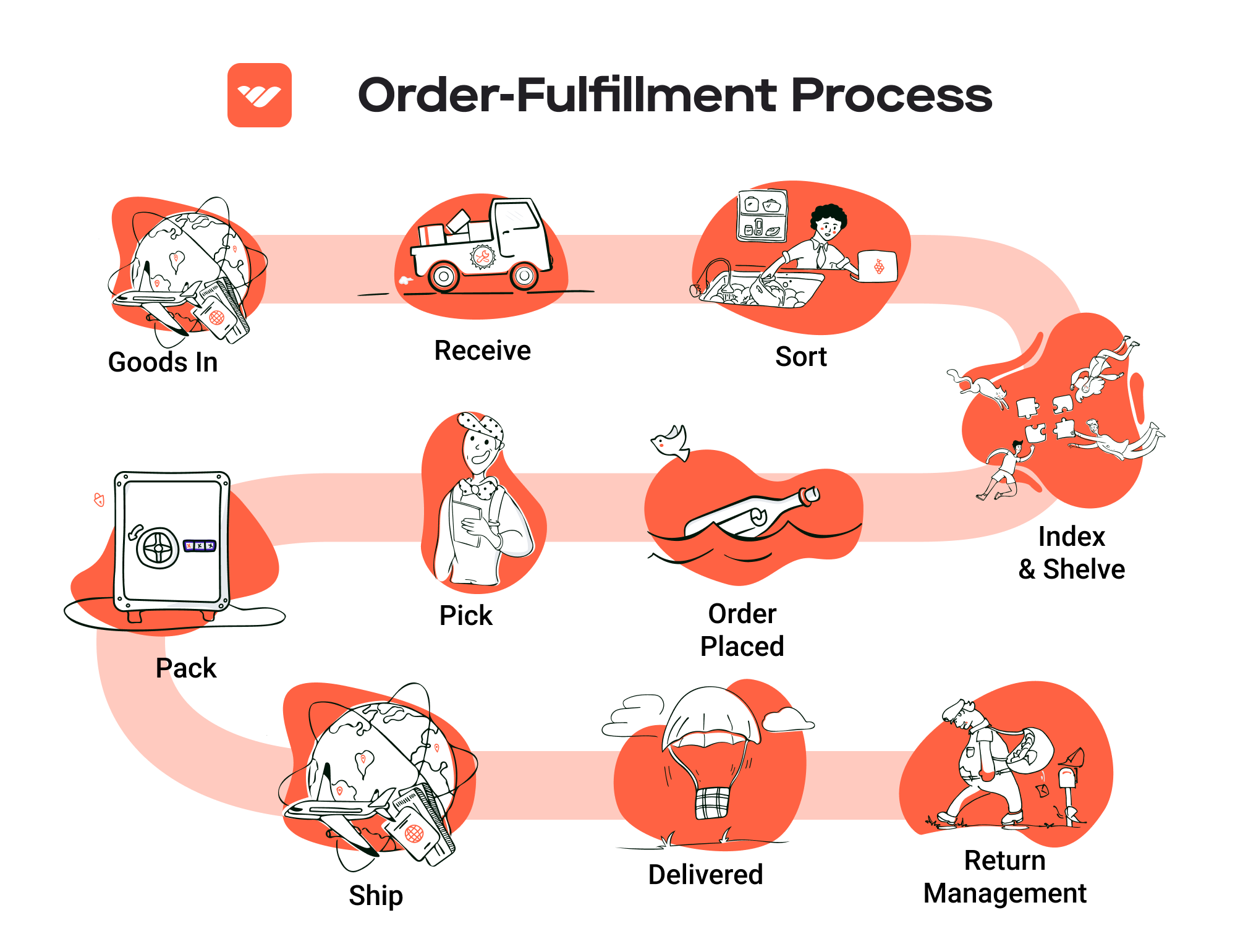
Key Term: Last Mile Delivery – The final step of the delivery process where the product is transported from a distribution center to the end customer, often considered the most critical and costly segment of the shipping process.
By understanding and optimizing each of these steps, e-commerce businesses can create a robust order fulfillment process that enhances customer satisfaction and supports growth. Effective order fulfillment is not just about getting products out the door; it’s about creating a seamless experience that encourages repeat business and strengthens brand loyalty.
Comparing Fulfillment Models: In-House vs. 3PL vs. Dropshipping
Fulfillment Model Comparison
| Model | Who Handles Inventory | Best For (Business Stage) | Key Advantage | Key Disadvantage |
|---|---|---|---|---|
| In-House Fulfillment | The business itself | Established businesses | Full control over inventory and operations | High overhead costs and resource demands |
| Third-Party Logistics (3PL) | A specialized logistics provider | Growing businesses | Scalability and expertise in logistics | Less control over operations and potential communication issues |
| Dropshipping | Supplier or manufacturer | Startups and small businesses | Low upfront investment and minimal risk | Lower profit margins and reliance on supplier reliability |
In-House Fulfillment
In-house fulfillment is a model where the e-commerce business manages its inventory, warehousing, and order processing internally. This approach provides businesses with complete control over their operations, enabling them to tailor processes to their unique needs. For established businesses, in-house fulfillment can lead to greater efficiency, as companies can streamline their operations without the complexities of external partnerships. Moreover, having direct oversight allows for improved quality control, faster decision-making, and the ability to create a more personalized customer experience.
However, in-house fulfillment comes with its challenges. The initial investment in infrastructure, technology, and staffing can be significant. Businesses must also manage ongoing costs such as rent, utilities, and labor, which can strain resources, especially for smaller companies. Additionally, the operational demands can divert attention from core business activities, potentially hindering growth if not managed properly.
Third-Party Logistics (3PL)
Third-party logistics (3PL) is a fulfillment model where businesses outsource their warehousing and distribution needs to specialized logistics providers. This model is particularly beneficial for growing businesses that need to scale quickly without the burdens of managing their own fulfillment operations. 3PL providers, like DCG Fulfillment, offer a range of services, including inventory management, order processing, and shipping, leveraging their expertise and infrastructure to optimize supply chain efficiency.
One of the key advantages of 3PL is scalability. As businesses grow, 3PL providers can easily adjust to increased demand, allowing companies to focus on marketing and sales rather than logistics. Additionally, 3PLs often have established relationships with carriers, which can lead to better shipping rates and faster delivery times. However, the downside is that businesses may face less control over their inventory and fulfillment processes, which can lead to communication challenges and potential discrepancies in order fulfillment.
Dropshipping
Dropshipping is a fulfillment model where the retailer does not keep products in stock. Instead, when a customer makes a purchase, the retailer forwards the order to a third-party supplier, who then ships the product directly to the customer. This model is particularly appealing to startups and small businesses due to its low upfront investment and minimal risk. Retailers can offer a wide range of products without the need to invest in inventory, warehousing, or shipping logistics.
The main advantage of dropshipping is its low barrier to entry. Entrepreneurs can start an e-commerce business with limited capital, testing product viability before committing to larger inventory purchases. Additionally, since the supplier handles inventory and shipping, business owners can focus on marketing and customer engagement. However, dropshipping also has its drawbacks. Profit margins can be lower due to reliance on suppliers, and there is an inherent risk in depending on third-party vendors for product quality and shipping reliability. Any delays or issues on the supplier’s end can directly impact the retailer’s reputation and customer satisfaction.
Conclusion
Choosing the right fulfillment model depends on various factors, including the business’s size, growth stage, and operational capacity. In-house fulfillment offers control and customization but at a higher cost and resource commitment. Third-party logistics provide scalability and expertise, making them ideal for growing businesses but may lead to communication challenges. Dropshipping presents a low-risk entry into e-commerce but can result in lower profit margins and reliance on suppliers. Understanding these dynamics will help business owners make informed decisions that align with their growth strategies and operational capabilities.
A Deep Dive into Amazon FBA: Pros, Cons, and Who It’s For
Understanding Fulfillment by Amazon (FBA)
Fulfillment by Amazon (FBA) is a service provided by Amazon that enables sellers to store their products in Amazon’s fulfillment centers. Amazon then takes care of storage, packaging, and shipping of the products directly to customers. This service is designed to streamline the logistics process for e-commerce sellers, allowing them to focus more on marketing and sales rather than the complexities of order fulfillment. When a customer places an order for a product fulfilled through FBA, Amazon handles all aspects of the transaction, including customer service and returns.
How FBA Works
-
Setting Up: Sellers create an Amazon seller account and list their products. They can choose which products they want to fulfill through FBA.
-
Shipping Inventory: Sellers ship their products to Amazon’s fulfillment centers. Amazon provides guidelines for how to package and label the products to ensure they are ready for storage.
-
Storage: Once the products arrive at the fulfillment centers, Amazon takes care of storing them until they are sold. Sellers can track their inventory through the Amazon Seller Central dashboard.
-
Order Fulfillment: When a customer orders a product, Amazon picks, packs, and ships the item on behalf of the seller. The seller does not have to worry about the logistics of getting the product to the customer.
-
Customer Service: Amazon manages all customer service inquiries and returns for FBA orders, which can significantly reduce the workload for sellers.
-
Payment: After the sale is completed, Amazon collects the payment and disburses the earnings to the seller, minus the fees associated with the FBA service.
Pros of Fulfillment by Amazon
-
Prime Eligibility: Products fulfilled through FBA are eligible for Amazon Prime, which can significantly enhance visibility and sales. Prime members are more likely to purchase items that have the Prime badge due to the promise of fast and free shipping.
-
Customer Trust: Amazon has established a high level of trust among consumers. By using FBA, sellers can leverage Amazon’s reputation for reliability and customer service, which can lead to increased sales and repeat customers.
-
Multi-Channel Fulfillment: FBA allows sellers to fulfill orders not only from Amazon but also from other sales channels, such as their own websites or other e-commerce platforms. This provides flexibility and can help streamline logistics across different sales platforms.
-
Scalability: FBA offers a scalable solution for e-commerce businesses. As sales grow, sellers can easily scale their inventory and fulfillment without the need for additional warehousing or logistics infrastructure.
-
Time Savings: By outsourcing fulfillment to Amazon, sellers can focus on other critical aspects of their business, such as product development and marketing, rather than logistics and shipping.
Cons of Fulfillment by Amazon
-
High Fees: FBA comes with various fees, including storage fees, fulfillment fees, and additional charges for long-term storage. These costs can add up, especially for sellers with lower-margin products, potentially cutting into profits.
-
Strict Inventory Rules: Amazon has stringent rules regarding inventory management, including guidelines for packaging, labeling, and even inventory performance metrics. Sellers must comply with these rules to avoid penalties or account suspensions.
-
Commingling Risks: With FBA, products from different sellers can be stored in the same location. This commingling can lead to issues if products are lost or damaged, as it may be difficult to trace the origin of a specific item. Sellers risk having their products associated with negative reviews or returns stemming from issues with another seller’s inventory.
-
Loss of Control: When using FBA, sellers relinquish some control over the fulfillment process. This can be challenging for businesses that wish to maintain a strong brand experience through personalized packaging or customer interaction.
-
Inventory Limitations: Amazon imposes limits on the amount of inventory sellers can store in its fulfillment centers, particularly for new sellers or those with low sales velocity. This can restrict the ability to scale quickly or to hold sufficient stock during peak selling seasons.
Who is FBA Best For?
Fulfillment by Amazon is particularly well-suited for:
-
Small to Medium-Sized Businesses: Companies that lack the infrastructure to manage their own fulfillment can benefit significantly from FBA’s comprehensive service offerings.
-
E-commerce Entrepreneurs: New sellers looking to establish their presence in the market can leverage Amazon’s vast customer base and trusted services to gain traction.
-
Sellers with High-Volume Products: Businesses that sell high-volume, low-margin products may find that the convenience of FBA offsets the associated fees, allowing them to scale more effectively.
-
Brands Looking for Exposure: Established brands seeking to reach a wider audience through Amazon’s platform can benefit from the enhanced visibility and trust associated with FBA.
-
Multi-Channel Sellers: E-commerce businesses that sell across different platforms can use FBA to streamline their fulfillment process, ensuring a consistent customer experience regardless of where the sale occurs.
In conclusion, Fulfillment by Amazon provides a powerful tool for scaling e-commerce operations, but it is essential for business owners to weigh the pros and cons carefully. Understanding the unique needs of your business and how FBA aligns with your goals will ultimately determine if it is the right fulfillment strategy for you.
Core Services Offered by Fulfillment Centers
Inventory Management & Warehousing
Inventory management and warehousing are foundational services offered by fulfillment centers, critical for e-commerce businesses aiming to maintain efficiency and customer satisfaction. This service involves the systematic tracking and storage of products within a warehouse environment. Fulfillment centers utilize advanced warehouse management systems (WMS) to provide real-time visibility into inventory levels, product locations, and stock movements.
Benefits:
– Accuracy: By employing sophisticated inventory tracking technologies, fulfillment centers reduce the chances of stock discrepancies, ensuring that businesses have the right amount of stock on hand.
– Cost Efficiency: Effective inventory management minimizes holding costs and reduces the risks associated with overstocking or stockouts, ultimately leading to better cash flow management.
– Scalability: As e-commerce businesses grow, fulfillment centers can easily adjust their warehousing capacities, allowing for seamless scaling of operations without the need for significant capital investment in physical space.
– Streamlined Operations: Centralized inventory management enables businesses to operate more efficiently, responding quickly to customer demands and fluctuations in market trends.
Pick and Pack Services
Pick and pack services are essential for e-commerce businesses that require efficient order fulfillment. This process involves selecting items from inventory (picking) and packaging them for shipment (packing). Fulfillment centers like DCG Fulfillment leverage state-of-the-art technology to enhance accuracy and speed during the order fulfillment process.
Benefits:
– Speed: With streamlined pick and pack processes, fulfillment centers can significantly reduce the time it takes to fulfill orders, leading to faster delivery times and improved customer satisfaction.
– Customization: Many fulfillment centers offer customizable packing solutions, allowing businesses to create branded packaging or include promotional materials, enhancing the customer experience.
– Error Reduction: Advanced scan verification processes help to ensure that the correct items are picked and packed, reducing the likelihood of returns due to fulfillment errors.
– Scalability: As order volumes increase, fulfillment centers can scale their pick and pack operations, accommodating seasonal spikes in demand without compromising service quality.
Kitting and Assembly
Kitting and assembly services involve the grouping of individual items into ready-to-sell sets, or the assembly of products that require multiple components. This service is particularly beneficial for e-commerce businesses that offer bundled products or need to prepare items for retail displays.
Benefits:
– Enhanced Value Proposition: By offering kitted products, e-commerce businesses can provide customers with perceived value, encouraging higher sales and customer loyalty.
– Efficiency: Kitting services streamline the assembly process, allowing businesses to focus on core operations while the fulfillment center manages the intricate details of product assembly.
– Inventory Optimization: Kitting can help manage inventory more effectively by combining slow-moving items with popular products, improving overall inventory turnover rates.
– Custom Solutions: Fulfillment centers can tailor kitting services to meet specific business needs, whether for seasonal promotions or unique product offerings, allowing for greater flexibility in marketing strategies.
Returns Management (Reverse Logistics)
Returns management, or reverse logistics, is a critical service offered by fulfillment centers that deals with the processing of returned goods. This service is essential for e-commerce businesses, as it directly impacts customer satisfaction and loyalty. Fulfillment centers manage the entire returns process, from receiving returned items to restocking or disposing of them.
Benefits:
– Customer Retention: A well-handled returns process can enhance customer satisfaction and loyalty, as customers appreciate hassle-free returns. This is crucial for e-commerce businesses that often rely on repeat customers.
– Cost Management: Effective returns management helps businesses minimize losses associated with returned products, ensuring that items are promptly restocked or processed for resale.
– Data Insights: Analyzing return data can provide valuable insights into customer behavior and product performance, enabling businesses to make informed decisions regarding inventory and marketing strategies.
– Streamlined Operations: Fulfillment centers often have established processes for handling returns, allowing e-commerce businesses to focus on growth while ensuring that their returns are managed efficiently and effectively.
In conclusion, partnering with a fulfillment center to leverage these core services can significantly enhance the operational efficiency of e-commerce businesses. By outsourcing inventory management, pick and pack services, kitting, and returns management, businesses can focus on scaling their sales while ensuring that their logistics are handled by experts in the field.
How to Choose a Fulfillment Partner: A 6-Point Checklist
Location & Warehouse Network
Importance: The geographical location of your fulfillment partner’s warehouses can significantly impact shipping times and costs. A partner with strategically located facilities can reduce transit times, improve customer satisfaction, and lower shipping expenses.
Questions to Ask:
– Where are your warehouses located, and how do they align with my target markets?
– Do you have a network of warehouses that allows for efficient distribution?
– What shipping carriers do you work with, and how do they affect delivery times and costs?
Technology & Integrations
Importance: A robust technology platform is critical for seamless operations. Advanced Warehouse Management Systems (WMS) can enhance inventory accuracy, streamline order processing, and provide real-time visibility into stock levels. Additionally, the ability to integrate with your existing e-commerce platforms, such as Shopify or WooCommerce, is essential for a smooth workflow.
Questions to Ask:
– What technology do you use for warehouse management, and how does it enhance operational efficiency?
– Can your systems integrate with my current e-commerce platform and ERP systems?
– Do you provide real-time tracking and reporting capabilities? How accessible is this data?
Specializations (e.g., cold storage, oversized items)
Importance: Different businesses have unique logistical needs. If your products require special handling, such as cold storage for perishables or specific arrangements for oversized items, ensure your fulfillment partner has the necessary capabilities and experience.
Questions to Ask:
– Do you have specialized facilities for my product type, such as temperature-controlled storage or handling for fragile items?
– Can you accommodate unique packaging or kitting requirements?
– What experience do you have in managing logistics for my specific industry or product type?
Scalability & Capacity
Importance: As your business grows, your fulfillment needs will evolve. A partner that can scale operations in line with your growth is crucial for long-term success. Understanding their capacity to handle increased order volumes or seasonal spikes can help prevent service disruptions.
Questions to Ask:
– How do you handle fluctuations in order volume, such as during peak seasons?
– Can you provide examples of how you’ve scaled operations for other clients?
– What measures do you have in place to ensure you can accommodate my growth?
Pricing and Contracts
Importance: Understanding pricing structures and contract terms is essential to avoid unexpected costs that can erode your profit margins. Transparency in pricing can help you assess the financial viability of a partnership.
Questions to Ask:
– What is your pricing model (e.g., per order, per item, monthly fees), and are there any additional costs I should be aware of?
– Are there minimum order requirements or long-term contracts that I need to consider?
– How do you handle pricing for international shipping or special services?
Customer Support & Reviews
Importance: Quality customer support is vital for addressing issues promptly and maintaining smooth operations. Additionally, reviews from other businesses can provide insights into the reliability and performance of the fulfillment partner.
Questions to Ask:
– What customer support options do you offer (e.g., phone, email, chat), and what are your response times?
– Can you provide references or case studies from current or past clients?
– How do you handle issues that arise during the fulfillment process, and what is your protocol for resolving disputes?
Conclusion
Choosing the right fulfillment partner is a critical decision that can influence your e-commerce business’s efficiency and customer satisfaction. By using this checklist, you can systematically evaluate potential partners based on their location, technology, specializations, scalability, pricing, and customer support. This thorough assessment will help you make an informed decision, ensuring that your logistics operations align with your business goals and growth strategy.
Understanding Fulfillment Pricing: A Breakdown of Common Fees
Initial Setup Fees
Initial setup fees are the costs associated with establishing a new account with a fulfillment service provider. These fees cover the administrative tasks required to onboard your business, such as setting up your inventory in their warehouse management system (WMS), configuring your account settings, and integrating their systems with your e-commerce platform.
Typically, these fees can range from a few hundred to several thousand dollars, depending on the complexity of your operations and the provider’s requirements. Factors that can influence this cost include the number of products you offer, the need for custom software integrations, and any specific labeling or packaging requirements you might have. It’s crucial to clarify what is included in these fees, as some providers may bundle additional services that could save you money in the long run.
Receiving Fees
Receiving fees are charged when your inventory arrives at the fulfillment center. This fee compensates the provider for the labor involved in unloading, inspecting, and storing your products. The calculation of receiving fees can vary, but they are often based on the number of pallets or cartons received, the weight of the shipment, or the total volume of goods.
For instance, if you send a shipment consisting of multiple pallets, you might be charged a flat rate per pallet, or it could be a tiered pricing structure where the first few pallets are charged at one rate and additional pallets at a lower rate. Understanding these fees is critical, especially for businesses that frequently replenish stock, as they can significantly impact your overall fulfillment costs.
Storage Fees (per pallet/bin)
Storage fees are incurred for keeping your inventory in the fulfillment center. These fees can be charged on a per-pallet or per-bin basis, depending on how your products are stored. Typically, storage fees are calculated on a monthly basis and are based on the space your products occupy.
For example, a common pricing model might charge a fixed rate per pallet per month, with discounts available for larger quantities. Additionally, some providers may charge a premium for items that require special handling or climate-controlled storage. It’s important to monitor your inventory turnover rates to avoid overpaying for storage, particularly for slow-moving items.
Pick & Pack Fees (per item/order)
Pick & pack fees are charged for the labor involved in picking items from storage and packing them for shipment. This fee can be structured in various ways, often based on the number of items per order or the number of unique SKUs picked.
For example, a fulfillment center might charge a base fee for the first item and then an additional fee for each item thereafter. Some providers may also offer a flat rate for orders with a specific number of items, which can be beneficial for businesses with a high volume of similar orders. Understanding how these fees are structured can help you optimize your order processing and minimize costs.
Shipping Fees
Shipping fees are the costs associated with transporting your packages to customers. These fees can vary widely based on several factors, including the shipping method (standard, expedited, etc.), the weight and dimensions of the package, the destination, and any additional services such as insurance or signature confirmation.
Fulfillment providers often have partnerships with major carriers, which can lead to discounted shipping rates. However, it’s essential to evaluate these options carefully. Some providers may charge a handling fee in addition to the actual shipping costs, so it’s crucial to understand the full scope of these charges when budgeting for fulfillment.
Tips for Getting an Accurate Quote
-
Provide Detailed Information: When requesting a quote, be as detailed as possible about your inventory, order volume, and specific needs. This helps providers give you a more accurate estimate.
-
Ask About Fee Structures: Inquire about how each fee is calculated and whether there are any additional costs that might arise. Understanding the fee structure will help you avoid surprises later on.
-
Consider Future Growth: Discuss your growth plans with potential providers. They should be able to accommodate your scaling needs and adjust pricing accordingly.
-
Negotiate Terms: Don’t hesitate to negotiate the terms of your agreement. Many providers are willing to offer discounts for longer contracts or higher volumes.
-
Request a Trial Period: If possible, ask for a trial period to assess the fulfillment service without committing long-term. This can help you gauge the provider’s capabilities and fee structures in practice.
By understanding these common fulfillment pricing models and following these tips, you can make informed decisions that align with your business’s operational needs and budgetary constraints.
Frequently Asked Questions (FAQs) about Fulfillment
1. What is DCG Fulfillment?
DCG Fulfillment is a family-owned third-party logistics (3PL) provider based on the West Coast, specializing in warehousing and distribution services since 2001. With a focus on customer service and operational excellence, DCG has experienced significant growth, primarily driven by referrals from satisfied clients.
2. What services does DCG Fulfillment offer?
DCG Fulfillment provides a comprehensive range of services, including:
– Order Pick-N-Pack/Fulfillment: Efficient processing of open-case fulfillment.
– Cross Docking/Transloading: Streamlined transfer of goods between transport vehicles.
– Value-Added Labor/Kitting: Custom assembly and packaging solutions.
– Contract Warehousing: Long-term warehousing arrangements tailored to client needs.
– Distribution Services: Effective management of goods movement from warehouse to customer.
3. What is a 3PL?
A third-party logistics (3PL) provider offers outsourced logistics services, including warehousing, transportation, and fulfillment. By partnering with a 3PL like DCG Fulfillment, businesses can focus on their core operations while leveraging the expertise and resources of a specialized logistics provider.
4. How does DCG Fulfillment ensure order accuracy?
DCG Fulfillment employs advanced systems, including Sterling nWMS, which provides real-time visibility into inventory and order processing. The implementation of scan verification processes and the ability to print content lists for orders help maintain high accuracy levels throughout the fulfillment process.
5. How much do fulfillment services cost?
The cost of fulfillment services varies based on several factors, including order volume, storage needs, and the specific services required. At DCG Fulfillment, we offer competitive rates and can design a customized program that aligns with your business needs. For a detailed quote, it’s best to contact us directly.
6. What is the difference between a warehouse and a fulfillment center?
A warehouse primarily focuses on the storage of goods, while a fulfillment center is designed for the complete order fulfillment process, including picking, packing, and shipping products directly to customers. Fulfillment centers, like DCG, are equipped to handle the complexities of e-commerce logistics.
7. How can I track my orders with DCG Fulfillment?
DCG Fulfillment utilizes a state-of-the-art warehouse management system (WMS) that provides real-time tracking of orders and inventory levels. Clients can access this information through a user-friendly dashboard, ensuring they are always informed about their shipment status.
8. Can DCG Fulfillment handle seasonal fluctuations in order volume?
Yes, DCG Fulfillment is equipped to manage seasonal spikes in order volume efficiently. We strategically onboard new accounts without compromising service quality, ensuring that we can scale operations to meet your business’s fluctuating demands.
9. What industries does DCG Fulfillment serve?
DCG Fulfillment caters to a diverse range of industries, including retail, e-commerce, and consumer products. Our adaptable services are tailored to meet the unique needs of each sector, ensuring clients receive the best possible support for their logistics requirements.
10. How do I get started with DCG Fulfillment?
To begin your partnership with DCG Fulfillment, you can reach out to us through our website for a quick quote or consultation. Our team will work with you to understand your specific needs and develop a tailored fulfillment strategy that supports your business goals.
Conclusion: Is Outsourcing Fulfillment the Right Move for Your Business?
Key Benefits of Outsourcing Fulfillment
Outsourcing fulfillment can be a transformative strategy for e-commerce businesses looking to scale. One of the most significant advantages is time savings. By delegating logistics and order processing to a third-party fulfillment partner, you can free up valuable resources and focus on core business activities like marketing, product development, and customer engagement. This shift allows for a more strategic approach to growth, ensuring that your team can concentrate on driving sales rather than getting bogged down in operational details.
Another critical benefit is scalability. As your business experiences fluctuations in demand—whether seasonal spikes or rapid growth—an experienced fulfillment partner can adapt quickly to changing needs. This flexibility not only helps in managing inventory efficiently but also ensures that your customers receive their orders promptly, thereby enhancing their overall experience and loyalty to your brand.
Moreover, partnering with a fulfillment service provides access to specialized expertise. Companies like DCG Fulfillment leverage advanced warehouse management systems and logistics technology that may otherwise be too costly or complex for smaller businesses to implement on their own. This expertise translates into improved accuracy, reduced shipping times, and optimized inventory management, all of which are essential for maintaining a competitive edge in the e-commerce space.
Choosing the Right Partner
However, the benefits of outsourcing fulfillment hinge on selecting the right partner. It’s crucial to evaluate potential fulfillment providers based on their track record, technology capabilities, and customer service standards. A well-aligned partner can significantly impact your operational efficiency and customer satisfaction.
Call to Action
As you consider your fulfillment strategy, take the time to audit your current shipping processes. Assess whether your existing setup aligns with your growth ambitions or if a dedicated fulfillment partner could streamline operations and enhance customer experience. Engaging with a professional provider could be the next strategic step in scaling your e-commerce business effectively.
Important Disclaimer
⚠️ Important Disclaimer
The information in this guide is for educational purposes. Fulfillment services, pricing, and platform features change frequently. Always conduct your own due diligence and consult with providers directly before making business decisions.
